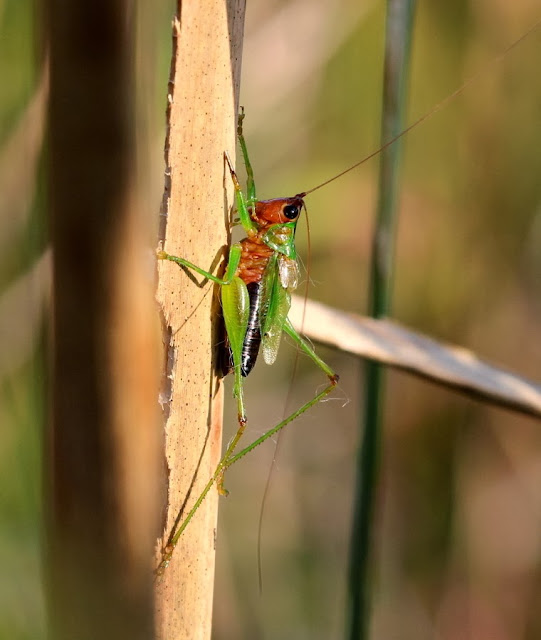We have a truly gorgeous little meadow katydid here in northern Ohio that most of you have never seen – the Black-sided Meadow Meadow Katydid (Conocephalus nigropleurum). Unlike our widespread Short-winged and Slender Meadow Katydids that can be found in a variety of rather accessible habitats, Black-sided Meadow Katydids are specifically a wetland species. They are not in every marshy area, either, and may reside in just one small part of a larger habitat. If you’d like to search for them, you’ll probably want to wear your knee-high waterproof boots and be prepared to stand around for a while in dense cattails that are over your head.
If you are lucky, these little beauties may gradually reveal themselves. As they become comfortable with your large and comparatively clumsy presence, you will see them run up and down cattail leaves and stems, climbing quickly and gracefully from one leaf to another.
You may also see them on the cattail seed heads, either singing or dining on the seeds.
They are well worth the search – just look at how stunning they are! This photo is the female, who is every bit as stunning as the male.
They are so colorful! Black sides, green wings, red faces, black eyes…but can they sing? Really, now, can you actually hear them?
This is one soft, light, high song! It is easier to see a male’s wings moving than it is to actually hear him. In fact, that’s exactly how I recorded this species – by aiming my shotgun microphone right at a male’s wings at a distance of no more than 2 inches! Even then, I had to trust that I was recording him, because it seemed that every other sound was louder.
Black-legged Meadow Katydids seem to be everywhere that I find Black-sided Meadow Katydids.
Black-leggeds live in the same habitat and in numerous other habitats in wet and even just somewhat damp areas. Their songs are much louder and completely dominate the cattail concert hall. In addition, tree and ground crickets will probably be singing nearby, possibly joined by a Sword-bearing Conehead or two in the evening. Birds from chickadees to geese may be calling during the day. And of course, humans are likely to be contributing the sounds of cars, trucks, ATVs, aircraft, landscaping equipment, and more. Recording Black-sideds is quite a challenge!
I had recorded a Black-sided Meadow Katydid a few years ago from just a few inches away, but I had to admit that the nearby Black-legged Meadow Katydid was much louder in that recording. I decided a couple of weeks ago that I simply had to do better – but how? Just finding these katydids at all is itself an undertaking.
I’d seen them in a couple of locations in my area but only knew of a few locations where I could find them. When Geauga Park District naturalist Linda Gilbert told me she’d recently seen some Black-sideds in a stand of cattails in a gas line clearing, I had to visit this new location. When I found the cattails and saw a male begin to sing, I thought I was in luck - but not for long.
On a large cattail seed head next to my little singer, not one, but FOUR male Black-legged Meadow Katydids were attempting to impress one female who was also on the same cattail. Even after a couple of them literally threw off two other males, I still couldn’t get a clear enough recording of the little Black-sided.

Here’s the best I could do - he just sounds like filler while the Black-leggeds are the soloists.
My luck improved at the next location I tried: Beartown Lakes in the Geauga Park District. The nearest Black-legged was far enough away that I could actually isolate the song of the Black-sided. It is soft and it is high. The frequency ranges seems to be between 8000 and at least 20,000 Hz, with the primary frequencies being between 12,000 and 14,000 Hz.
Could you hear it? I hope your speakers will reproduce those high frequencies for you!
I must admit, I am quite taken by these katydids. They are beautiful, and I’ve gotten to know them better by spending the time and attention necessary to record them. Keep your eyes on the cattails, and I hope you have a chance to see them – and maybe even hear them!









I have not seen them! But will keep my eyes out for them now!
ReplyDelete